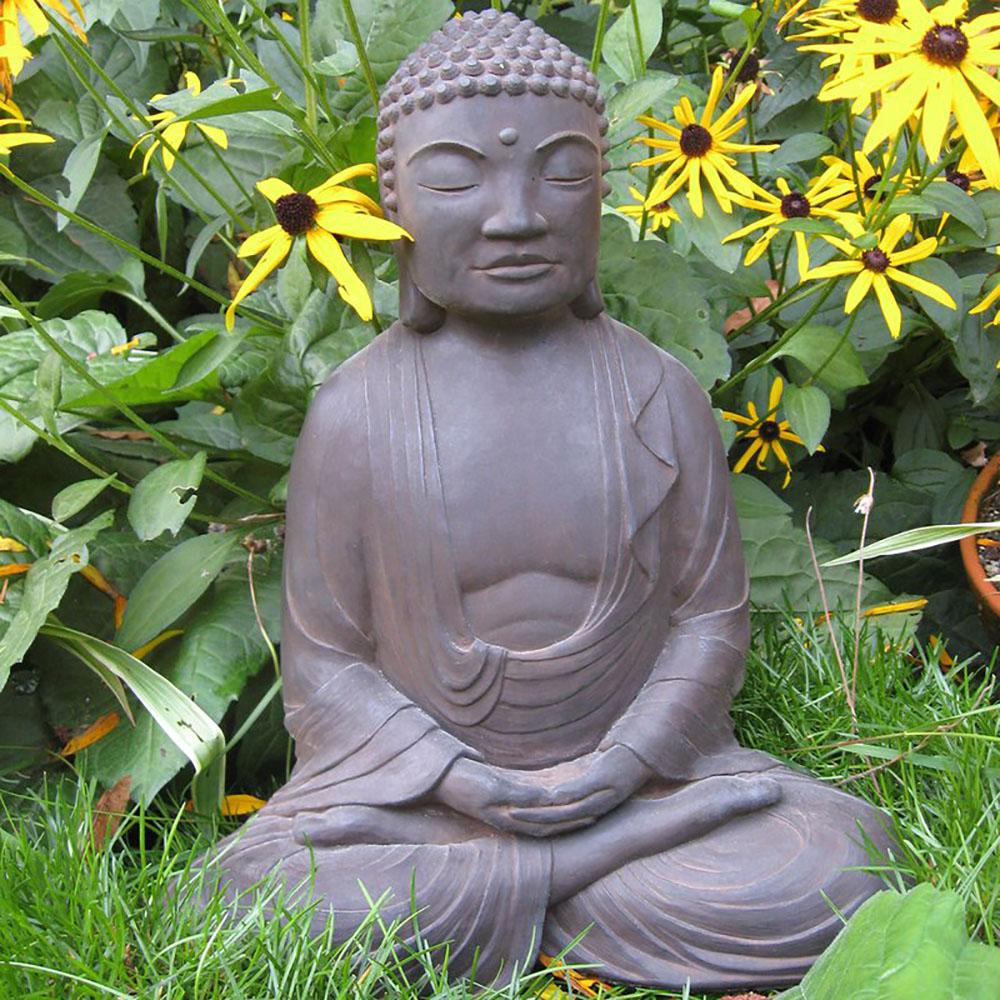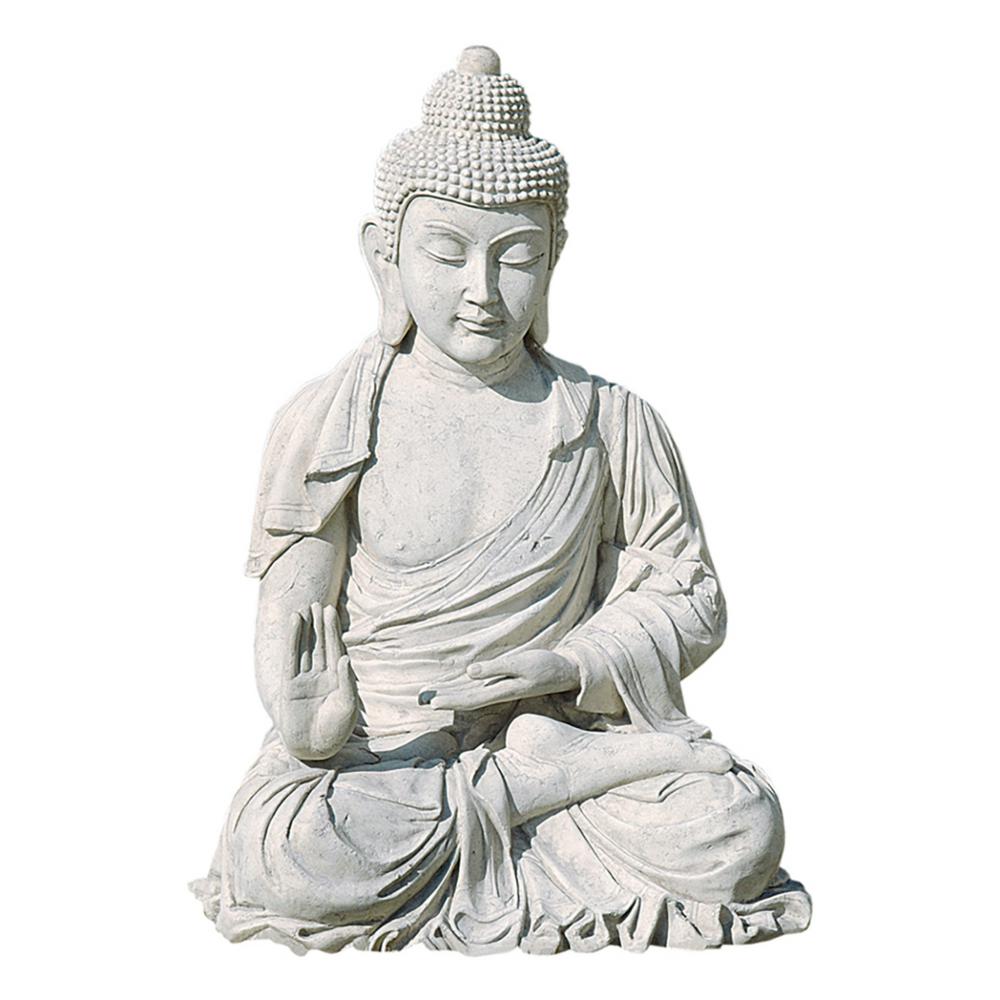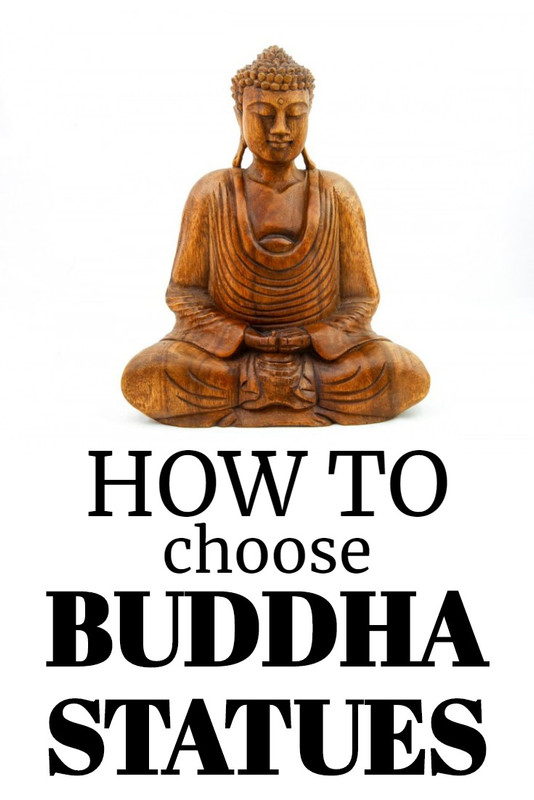When choosing a Buddha statue, the thing you should keep in mind is that the whole process shouldn’t stress you out.
If it stresses you out, then it is not really something that’s worth your time. The process should be educational, enlightening, and in many cases fun as well.
With that in mind, you can begin your selection process just like how you normally would with a book or some products that you really like.
But first, have you heard that there are two statues most commonly confused with Buddha?
2 Most Commonly Confused Buddha Statues
There are two kinds of statues that are most commonly confused with the Buddha statues, they are: the Kuan Yin and the Budai.
Firstly:
1. Kuan Yin / Guan Yin / Kwan Yin
/kuan-yin-buddha.jpg)
Kuan Yin is a Chinese Bodhisattva as well as the male counterpart Bodhisattva Avalokiteshvara.
They are important in Buddhist cosmology because they have contributed their part to help mankind reach the insights and teachings of the Buddha.
They are, not to be mistaken, as the Buddha. You will often see Kuan Yin statues in Chinese temples and the male form in Tibet, Nepal, or India.
This Bodhisattva represents Buddhist teachings and all the educational value there is in them.
Kuan Yin often holds a small vase. In this vase, as it is told, is the holy water that Kuan Yin uses to clean the sins or ease the suffering of the humankind.
Now, shall we see next this happy-looking guy named Budai?
2. Budai / Ho Tai / Laughing Buddha
/laughing-buddha.jpg)
Although the name says that this is a “Buddha”, this is the part that gets many people confused.
Budai is actually a monk. He is one of a jolly nature and a good sense of humor. That is why many call him the Laughing Buddha.
Budai is often depicted with a big smile on his face, a chain of beads around his neck, and the robes that he wears.
To some extent, he is comparable to the West’s Santa because he was well-known for the bag of gifts he gave to children who came to learn about the Buddha’s teachings.
Even though Budai himself is not the historical Buddha, he is a great depiction of someone who follows the Buddhist tradition and still lives an interesting, fun and fulfilling life.
This is why the Laughing Buddha is one of the most popular gifts for young ones, friends, colleagues or even non-Buddhists alike, even though he himself is not a Buddha. But more accurately a Buddhist monk.
Knowing so, what are the different types of Buddha statues then:
3 Different Types of Buddha Statues
The only main differences you will often see in different Buddha statues are the body position, the hand position (mudra), and the leg position.
If you know a bit of these, you will recognize immediately the meaning of the statue the next time you buy one. First, we will see the body position.
1. The Body Position
There are 3 body positions that Buddha statues represent:
- Sitting
- Reclining
- Standing
For the first one:
Sitting
/sitting-buddha.jpg)
The sitting position depicts the Buddha meditating and practicing seeing deeply into the things around us.
It is the similar position that the Buddha was sitting, under the Bodhi tree, when first enlightened.
Reclining
/reclining-buddha.jpg)
The second position is the reclining pose. This pose may carry different meanings depending on the cultures or country.
Generally, it may represent the Nirvana attitude. The feeling of carefree and being detached from all worldly things, knowing that this vast universe is just so amazing. It can also mean, very simply, that the Buddha is taking a rest or sleeping.
Many also believe that this reclining pose depicts the Buddha during the last illness, when Buddha was about to escape the endless cycle of birth-death-rebirth and enter into Nirvana.
Even though the size of the statues may be different, one thing that you will notice is that the Buddha often rests on the right-hand side.
Although few people have actually raised this question, but it may possibly be that the Buddha is dominantly right-handed.
Standing
/standing-buddha.jpg)
You will find statues like Kuan Yin Bodhisattva in the standing position more often.
It may carry the meaning that high above they are watching us, our actions, and the actions of others. From that observation, justice will be served.
Balance will also be regained. You can trust the forces of nature to sort things out during your hardest times. Have faith.
The next thing we're looking at is the leg position of the statue:
| Choose Your Buddha Statues |
|---|
 |
| Better value than garden centers |
| Free delivery & install |
| Beautiful statues |
| eBay Amazon Home Depot |
2. The Leg Position
If the statue is in the seated position, there are often 2 most common leg poses:
- The single lotus
- The double lotus.
The Single Lotus
/single-lotus-position.jpg)
The first one is the single lotus position or half lotus. It is simply a crossed leg position. The left foot rests on top of the right thigh while the right foot is underneath the left thigh.
This posture creates some sort of a triangle shape. Geometrically, 3 points in space create a balanced surface.
And with a triangle created by your 2 knees and the point where your legs cross, you create a surface that is grounded and solid to sit on.
This is a good foundation for people who practice meditation and need to sit still for a long time. Their body, spine, and back won’t get sore or tired. Buddha statues have this leg position if you look closely.
The harder pose is this one:
The Double Lotus
/double-lotus-position.jpg)
Here, the only difference is that instead of putting your right foot underneath your left thigh, you bring it up on the left thigh and lock it into place–just like the foot on the other side.
As you can see, this creates symmetry. It creates a solid foundation to sit and meditate comfortably for a long period of time.
If you look at people who practice yoga, you will often find these two lotus positions as well. They are very common. And often, the double lotus is a slightly more advanced position that requires more practice.
The meaning behind these leg positions is to provide a solid, stable position for the practitioner or the Buddha to sit on, meditate, and won’t be bothered by the surrounding things. And of course, to reduce body pain.
Now that we've seen two types of non-Buddha statues, their body & leg positions, let's find out a much more interesting one:
| Beautiful Buddha statues |
|---|
 |
| 50% cheaper than garden centers |
| Free delivery & install |
| Durable stone |
| eBay Amazon Home Depot |
3. The Hand Position (Mudra)
This is the part where it gets interesting and at the same time confusing for many people. Simply because there are so many hand gestures or mudras that are depicted through Buddha statues.
Here are some of the most commonly known mudra and a bit of the meaning to help you choose more easily.
| Buddha Statue | Mudra | Meaning |
|---|---|---|
| Protection | Raised right hand, palm out | Protecting the owner during times of chaos & their own thoughts |
| Teaching | Thumb & index fingers pressed against each other, palm out | Learning, overcoming the fear of change, breaking out of one’s comfort zone |
| Meditating | Hands placed comfortably on lap | Regaining balance, clarity of mind, peace of soul |
Protection Buddha
/protection-buddha-statue.jpg)
When you see a Buddha statue with its right hand raised up and facing outward, you know that you’re looking at the Protection Buddha.
When we face something that we don’t like or that we think might harm us, we put our hand up with the palm facing outward to act as a shield protecting us from that potentially harmful thing.
It is the same for this Protection Buddha statue. If you look at the other hand of the Buddha, you may see that it’s calmly placed on the lap.
In a way, this can mean that while you are facing hardships or challenges and trying to protect yourself and your family, you still keep a calm attitude to overcome whatever life throws at you.
Another layer of meaning for this is courage. The courage to overcome your own self at times when your thoughts may not be the clearest. Looking at the statue with this meaning helps bring you back to your true self.
Here you will see next the:
Teaching Buddha
/teaching-buddha-statue.jpg)
With this mudra, the Buddha holds the right hand up, palm outward with the thumb and index finger pressing against each other forming a sort of almond or water drop shape.
This statue depicts the Buddha when giving out the first sermon after Enlightenment. This sermon was given to a small group who had discounted the Buddha’s teachings previously.
Like many other things in life, people usually resist and tend not to value ideas that are unfamiliar to them very acceptingly at first. We may see this as a kind of fear—the fear of change to do something uncomfortable or to push out of one’s comfort zone.
On the other side, it takes a fearless teacher to continue on with these lessons even when the feedback they receive is negative. Because they truly believe in the value that mankind can get out of the insights.
By pressing the tip of the thumb and the tip of the index finger against each other, the Buddha is trying to bring energetic harmony to the fears and worries inside the self and project better energy to those around. It is an actual practice in the art of Jin Shin.
In front of you right now is another beautiful statue called:
Meditation Buddha
/meditating-buddha-statue.jpg)
The hands are placed comfortably on the Buddha’s laps, with eyes either half-closed or open, and legs single-lotus crossed to do meditation.
The meditation Buddha projects the kind of energy that is calm, peaceful, and serene for people to look at and feel. Many have this statue in their shrine room or meditation room for moments in life when they need to pause and wind down.
The statue represents peace, serenity, and concentration. It is a good reminder to help you pause and get yourself together during times when you feel like your thoughts, yourself or everything seems to be falling apart. Remember one thing:
When things to be falling apart, they actually are falling into place
When Buying A Buddha Statue:
Sizes
| Buddha Statue Size | Recommended Places |
|---|---|
| Small figurines 1-5 inches | Inside car, on desk, on bookshelf |
| Medium statues 6 – 26 inches | Patio, front door, porch, shrine room |
| Giant statues 40 inches & up | Backyard, large rooms, front yard |
You can find Buddha statues available in many sizes—from tiny to huge ones.
One of the most practical ways to choose the right size is to think about ways in which you can integrate the statue into your own lifestyle.
Specifically, that means not just buying a statue and leave it there gathering dust. But instead incorporating the energy and the applying the Buddha’s teachings into your daily life.
For small sculptures, you can place them in your car, on the desk or bookshelf. For medium ones, placing them near the front door or a room would be fine. For extra-large statue, you may want to put it inside a large room or your backyard.
If you like, you can check out an easy read about right here.
Now You Know How to Choose a Buddy Buddha!
What are the 2 most commonly confused Buddha statues? Budai and ...
What are the 3 body positions of Buddha statues? Sitting, standing, and ...
What are the 2 leg positions we've seen? Lotus something ...
Finally, the hand positions (mudras) depict the what? Protection, teaching, and ...
You've known much more now, way to go! Hopefully with this info, you can go out & choose the suitable Buddha statue more confidently for yourself & your family.
One last question before leaving: Do Buddha statues bring good luck?
Responses to Readers' Questions
What about a kneeling Buddha?
--> Thanks for your question. I actually have not heard or seen such before. Will take a look into it.
Whether one choose Buddha's statue or his canvass picture in Living room ?
--> The decision, my friend, is totally up to the owner's heart.
Share or pin this post!


